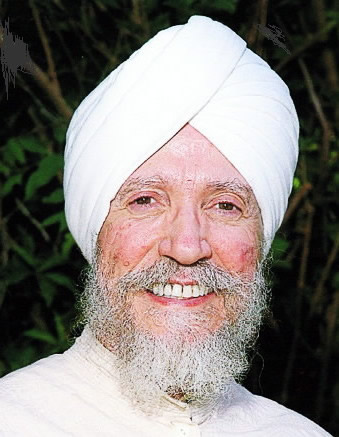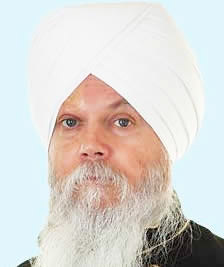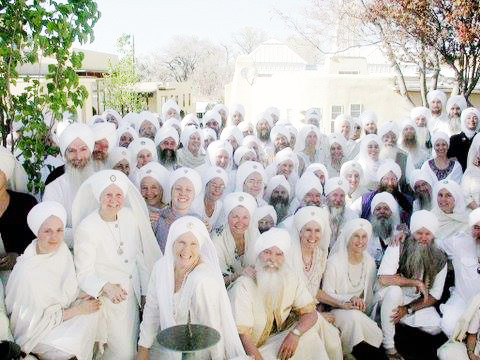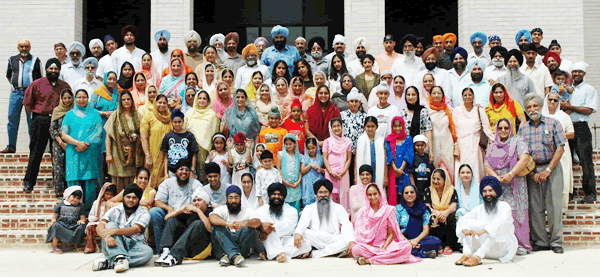My Sikh Sense

Hari Singh BIrd Khalsa
Are Sikh Gurdwaras dysfunctional?
Sat Nam. The following commentary by Baldev Singh Dhaliwal was received January 18, 2016. My reply follows, followed by Gursharan Singh, followed by Amarjit Singh Pabla.
My Sikh Sense

Baldev Singh Dhaliwal
 Are our Gurdwaras dysfunctional? DR. KARMINDER SINGH DHILLON explores the topic in a three-part series. In this part two, he makes an assessment. Readers are encouraged to share their views/comments which the author may incorporate into the remaining part." Are our Gurdwaras dysfunctional? DR. KARMINDER SINGH DHILLON explores the topic in a three-part series. In this part two, he makes an assessment. Readers are encouraged to share their views/comments which the author may incorporate into the remaining part."
Dr. Karminder Singh Dhillon quite rightly has set some lofty ideals for a Gurdwara, which may be used as a yardstick to assess the performance of one’s own Gurdwara. Not many will disagree that most Gurdwaras are likely to fall far short of those ideals.
His assessment again in step with those ideals follows a well-trodden path of what should be happening at our Gurdwaras, but does not. That assessment I believe to be generally true irrespective of the country we live in, but the reasons might be different owing to the circumstances and the history of Sikh settlement in those countries and the origin of the Gurdwaras in their localities.
I believe there won’t be much disagreement in the Panthic minded people that Gurdwaras ought to be the hubs of Sikh Dharma and the Sikh Way of Life, and Centres for learning.
The word “dysfunctional” to me though is a bit rough on the ears. Just like the question of who is a Sikh? A person says he is a Sikh but the other says he is not. Who is to say! If one says that a particular Gurdwara was “dysfunctional”, the management including most of the community will more than likely not accept that, but may accept that more could be done. May even successfully justify their difficulties! [See SikhTribes.com. Also see Where's The Love?]
As pointed out by the writer, there is a great deal wrong and to be desired in our parcharaks, gyanis and such like who impart knowledge to the sangats. And not without reason quite frequently are used as whipping boys. But can we really put the cause of all our ills, including the diminishing Gurdwara sangats, on their shoulders? Should we not be looking a bit deeper? Is it possible that they could be the result of our ills rather than the cause? We are after all living in free countries with intelligent and well-educated sangats. [Including parents, who I believe are the first in line with primary responsibility for their youth. To me parents are the first educators followed by the community.]
True that good management should provide good leadership, but then the management is elected (or selected) from the sangat by the sangat. I am not suggesting that matters are so simple but certainly that we should give some credit (or otherwise) to the sangat/ the community. To me making the Parcharaks as the primary target might be a bit too simplistic. The priorities of the community (including the parents) should, I believe, also be under scrutiny.
[I was a social/ community worker for our local multicultural farming community (South Australia) for about 15 odd years. With the nature of the hard work and with the use of chemicals used on the farms, we (my colleagues and I) knew that their (the farmers) concern for their health and precautions ought to be their priority and primary consideration, but were not. Government funded information seminars, talks, workshops, check-ups etc. were organised specifically for the diverse cultural groups, but their attendance and interest used to be rather lacking. They of course had other priorities, not their health!]
In the 1950s in most towns of Malaysia, foundations for Gurdwaras along the lines that Dr. Karminder Singh has suggested were already there. The forefathers had built very practical Gurdwaras. In name they were Gurdwaras but in practice were more as Sikh Community Centres; Gurdwara hall, living quarters even for visitors/ travellers, kitchen area and open ground as padang (playground) on the premises. Travellers and some others often found refuge at the place. Educated and professional Sikhs in the community provided the lead in establishing Punjabi schools and got government approval for Punjabi teachers.
By the 1950s the Gurdwaras had dedicated Granthis/Gyanis and Punjabi teachers (or the Gyani also as the teacher) very often funded by the government, and a well-stocked Punjabi library. Well-established Punjabi Newspapers were already in existence. Sikh students almost compulsorily had to attend the Punjabi classes. The place used to be a drop in place for many including the youth. All, including the youth, participated in the diverse activities at the place including at Gurdwara functions. The older youths mentored the younger. Homegrown dedicated parcharaks traversed the country (I believe their centre was in Singapore).
Regular well-organised residential samelans/seminars were arranged for the gyanis, granthis, and teachers etc. by dedicated professionals. (The name of Headmaster Gurbachan Singh, then of Kuala Lipis, stands out very prominently.) Yes, I would say the Sikh community of the country was certainly geared for model Gurdwaras we dream of today, but did not! The youth of that period who will be grandparents of today and may be able to contribute towards the discussion!
The above are in way of sharing some thoughts towards the topic based on observations and experience. Dr. Karminder Singh has put a great deal of food for thought on our plates. Part Three, “Are our Gurdwaras Dysfunctional: The Root Causes,” is still to come. It should be of interest to the Sikh community and parbhandaks alike.
Gur Fateh,
Baldev Singh Dhaliwal JP
SEWA Network, Australia More Baldev Singh Dhaliwal. More Baldev Singh Dhaliwal. 
My Sikh Sense

Hari Singh BIrd Khalsa
 Waheguru Ji Ka Khalsa! Waheguru Ji Ki Fateh! Waheguru Ji Ka Khalsa! Waheguru Ji Ki Fateh!
The root cause of Gurdwara Dysfunction is Tribalism, i.e., the social tendency to live in loyalty to a tribe, social group or gang (tribe within a tribe) especially when combined with a strong negative attitude toward marginalized people outside the group; the opposite of pluralism, the no class, no caste, One Creator of Creation principle taught and championed by Guru Nanak Dev.
Tribalism (institutional shakti pad) breeds racism. The antidote to tribalism is something akin to a Sensitivity Summit in which meaningful and perhaps courageous conversations with and between people of color, women, and other marginalized groups can occur.
The human tendency to tribalism and its practice of exclusion offends the innate longing to belong that every human being yearns for, and it is anong the core issues underlying the strife afflicting and affecting most nations today, especially in the Middle East.
The answer: LIVE the life we teach.
In this Age of Social Media the mission of every Sikh community should be to promote more diversity and cultural competency as espoused by Guru Nanak Dev Ji, and thereby bring to the fore issues of color and caste for the purpose of uplifting people who have a history of being marginalized, using social media and other means as a platform to inform various communities of the life experiences and concerns of marginalized people with regard to the necessity for social change, social justice, inclusion, compassion, tolerance, cultural literacy, and growth in our human relations going forward in order to better facilitate the current worldwide shift in global consciousness from tribalism, instability, and extremism to harmony, cooperation and enduring peace.
This mission must start within.
Guru rakha!
Hari Singh Bird Khalsa
To serve is to succeed.
USA
Watch Tribalism For Those Who Dare.
From Gursharan Singh
 Dear All, Dear All,
Honest answer is, yes!
Gurdwaras are not catering to the needs of all segments. There is no program to educate our children. There is no program for other than Punjabi speakers. Most of the Gurdwara management is controlled by gangs. It's almost impossible to implement any reform in Gurdwaras. We are so used to hiding everything under the carpet. Our Granthi Singhs are exploited. The younger generation is leaving Gurdwaras due to the bad conduct of their management. We are not running our Gurdwaras as House of Guru Nanak, but as commercial shops.
If you need more information, please feel free to contact me.
With regards,
Gursharan Singh
MARA No. 0640600
Director Migration Law Consultants Pty Ltd
Shop 5, 146-152 Cleveland St, Chippendale, NSW-2008
Tel +61 2 9281 2122
Mob. +61 411 592 421
From Amarjit Singh Pabla
 Dear All, Dear All,
I agree with Gursharan Singh ji.
Unfortunately most of the time management committee members have no concept of good governance, equity, fairness and compliance. This is why most of Gurdwaras are involved in court cases most of the time.
Nobody donates to Gurdwara to fund court cases but this is what is happening.
We need to come up with a model structure to run a Gurdwara and a universal constitution to run the Gurdwara; otherwise we are doomed.
Sangat needs to learn how to align with principles not with personalities.
Regards,
Amarjit Singh Pabla
Perth, Australia
My Sikh Sense

Nirmal Singh
 Hari Singh ji has shared his message about tribalism being the main cause of social conflict before. He has now extended it to be the cause of Gurdwaras being or becoming dysfunctional. Hari Singh ji has shared his message about tribalism being the main cause of social conflict before. He has now extended it to be the cause of Gurdwaras being or becoming dysfunctional.
Maybe he would elaborate his approach a bit more. The adage to live the life one teaches is often made and applies universally in a varied manner to all the peoples of the world. (See my comment below.)
It however has its deeper inner contradi ctions with societal mores that are now assuming importance in our lives. A few examples, with no intent to denigrate any would help us grasp what I am trying to suggest.
Most religions tend to teach that their way is the only way and that others have lost the way for various reasons and seek conversions. Religions promote exclusionary practices in one from or the other, not the least in matters of rituals.
Religions ask for and celebrate those who made sacrifices, including supreme sacrifice, for religious causes, however obscure.
One can go on and on. The important part will be to be more specific where our tribal instincts are making us less pluralistic or our Gurdwaras are turning into dysfunctional mode.
Respectfully,
Nirmal Singh
PA
My Sikh Sense

Hari Singh BIrd Khalsa
The Sikh connection to Tribalism
"The major drivers in all societies are the divisive and
protectionist narrow majoritarian interests." -- Nirmal Singh
 Sat Nam, Nirmal Singh Ji. Sat Nam, Nirmal Singh Ji.
I am happy to expand more on the linkage I see between what I have observed within Gurdwara communities, other Sikh organizations, and tribalism, albeit a sensitive and painful issue for many of our brethren to engage and which is not unique to Sikh organizations.
BTW: In the interest of efficiency let me refer you to the definitions and other entries I have made on the My Sikh Sense web site. I also encourage readers to avail themselves of the numerous referenced llnks within the commentaries above for context and background.
The following entries have relevance within the Sikh community to our movement away from the basic teaching of pluralism as taught by Guru Nanak Dev Ji. My observations do not necessarily apply to all Gurdwara communities nor to other Sikh organizations, but the following definitions apply rather broadly within my Sikh experience, and my life experience as a person of color.
1.) INCESTUOUS: Excessively close human relations that are resistant to outside influence. This condition leads to a siege mentality, whereby systemic barriers are put in place, which in turn puts the organization at risk of becoming perverted in its policies and procedures. The organization becomes intractably resistant to change, feedback from the outside is blocked or rejected, and elitism and nepotism reign supreme. (Sound familiar?)
2.) SIEGE MENTALITY: A collective state of mind whereby a group of people (especially religious organizations) believes themselves to be constantly attacked, oppressed, or isolated in the face of the negative intentions of the rest of the world. Although a group phenomenon, the term describes both the emotions and thoughts of the group as a whole, and as individuals.
The result is an isolated and insolated attitude, which is overly fearful of other people, whereby feedback from the outside is blocked or rejected, and an intractably defensive attitude prevails. This state of mind is a dominant factor within tribalist groups. (Sound familiar? Watch Tribalism For Those Who Dare.)
3.) Looking at the only all Black family in Sikh Dharma, represented by the Sikh students of Siri Singh Sahib Ji, after 50 years from my perspective as a person of color I ask, why are there so few Black families? Of course there are African Americans represented, but they are disproportionate in number. (See 3HOHistory.com.)
And of course Sikhs do not proselytize, but this one all Black family indicates that while the Sikh Dharma technology has attracted many American Caucasian families in this 50 year time frame, the universal message of Guru Nanak Dev has not reached any significant number of colored eyes in America. Why? Could it be due to a tribalist attitude within Sikh Dharma?
4.) The attitude of the male-dominated hierarchy of the Indian Sikh community, including the SGPC, towards the rights and privileges of women (see women are more than this) is an indication of a tribalist/sexist attitude, which is out of sync with Guru Nanak's pluralism. These are a few correlations that can be made between Sikh Dharma and Tribalism. I'm sure more can be found with open eyes.
I appreciate the opportunity for dialogue. Thank you, Nirmal Singh Ji!
Be Sikh and be well.
Hari Singh Bird Khalsa
Akal Committee Thirteen
To serve is to succeed.
USA
"Our politics remains filled with division and discord, and everywhere we see
the risk of falling into the refuge of tribe and clan and anger at those who don't
look like us or have the same surnames or pray the way we do." Barack Obama
"We are going to have to guard against a rise in a crude sort of nationalism, or
ethnic identity, or tribalism that is built around 'us' and 'them'." Barack Obama
"As humanity moves into the Space Age, how will we resonate with Gray and
Greens, when we cannot relate well to Blacks, Browns and Gays?" Hari Singh
My Sikh Sense

SatHanuman Singh Khalsa
Sikh scholars get to the head, but not the heart.
 Sat Nam, Mukhia Singh Sahib ji. Sat Nam, Mukhia Singh Sahib ji.
I agree with your assessment. The study and teaching of Gurmat as stated by many Sikh scholars gets to the head, but not the heart. This requires a spiritual practice (Sadhana) and conscious living. It will require commitment, an awakening within the Soul of individuals, and their courage to challenge the status quo.
Culture must take a backseat to the Path of Guru Nanak Dev Ji's Teachings. It appears each religion tends to be trapped in their beliefs and rituals without the benefit of sufficient practice or experience of adequate technology.
Shift happens! And this requires a major shift as this Age of Aquarius grows in light, and as souls are aligned with the energy of Universal Consciousness, many of the issues you address will be resolved.
I look forward to the response from other Sikhs in this forum.
Mukhia Jathadar SatHanuman Singh Khalsa
USA
My Sikh Sense

Hari Singh BIrd Khalsa
Where are the women? Where is the diversity?
 Sat Nam. Great photo that you included in your recent commentary about Sikh Education, Jagpal Singh Ji! Where are the women? Sat Nam. Great photo that you included in your recent commentary about Sikh Education, Jagpal Singh Ji! Where are the women?
All males, no women and no Blacks

The absence of diversity seems to be a prevalent theme. All White-skins, or all Coffee-skins, or all men in photos like this are published by many Sikh organizations. Where are the woman, and where are the black-skins? What do these optics say about how effective and genuine our outreach is, and how true our alignment is with Guru Nanak Dev's message?
The photos below project a recurrent absence of diversity as well. This face of Sikh Dharma must appear hypocritical to our youth. Could these be indicative of why Sikh youth are not relating to Sikh Dharma?
All White-skins

All Coffee-skins

BTW: Nirmal Singh Ji previously asked me for specific examples of tribalism. These photos are food for thought. See more examples here.
Enough said.
Be Sikh and be well.
Hari Singh Bird Khalsa
USA
"As humanity moves into the Space Age, how will we resonate with Grays
and Greens, when we can't relate well to Blacks, Browns and Whites?"
My Sikh Sense

Nirmal Singh
 Hari Singh ji, thank you for your response and sharing further thoughts about your search and some of your impressions. Hari Singh ji, thank you for your response and sharing further thoughts about your search and some of your impressions.
The way I am understanding your search at the moment is that you have had an interest in exploring, if your impression about Sikhs being tribalist is well founded.
About your reference to elitism, nepotism, and siege mentality, my initial guess is that these characteristics are present among [Indian] Sikhs but may not be their defining traits.
Sikh elitism is what may be seen as anti-elitism in some cultures. If you read the Article by Akhtar Sandhu posted by Jagpal ji the other day, he infers that the Sikh leadership was weak because of their mistrust of the elite. However every social system even if it shuns the elite ends up creating its elite group. It has happened to us too - most of our leading religious leaders have been the products of Damdami Taksal; Amrit Dharis have had control over Gurdwaras and the like.
Nepotism as a label again presents difficulties. Most Sikhs are known not to help other Sikhs. They are partial to their families, sons particularly, regarding what they leave behind (tribal?) but I am not sure if you would term that to be cause enough to conclude they are nepotistic.
About siege mentality, Sikhs recognize they are a minority everywhere but are not, and have not been intimidated by that in their history.
It might be helpful Hari ji, if you try and draw more of us into conversation (see reply below) by sharing your perspective on so many issues that keep coming up and that way get cross sectional views on segments that fit into your search.
Let us hope there are other responses and this conversation ends up being more productive.
Thank you for being there. Do share more about your and your family's views and experiences as a Sikh family, your concerns, and the blessings behind your spirit of chardi kala.
Respectfully,
Nirmal Singh
PA
My Sikh Sense

Hari Singh BIrd Khalsa
Sikh silence is deafening.
 Sat Nam, Nirmal Singh Ji. Your response to my comments is greatly appreciated. Sat Nam, Nirmal Singh Ji. Your response to my comments is greatly appreciated.
I have been directing the Saadh Sangat's attention, especially the American community, to these matters for many months with almost no response. The subject of diversity, the perception of tribalism, and the absence of pluralism appear to be verboten for most Sikh students of Siri Singh Sahib Ji and much of the Indian Sikh community as well.
I find it quite astonishing that Sikhs with the destiny of taking Guru Nanak Dev's message into the Space Age are so timid at conversing about these issues.
About two years ago a small group of Sikhs proposed a motion to the Khalsa Council that will bring these issues forward for meaningful dialogue. The effort even to bring the proposal to the floor for a second failed for lack of support (siege mentality?). I also note that even this learning-zone@yahoogroups.com group appears to be reluctant to discuss related issues, your reply being a welcomed exception. Thank you, again!
"As humanity moves into the Space Age, how will we resonate with Grays
and Greens, when we can't relate well to Blacks, Browns and Whites?"
Chardi kalaa!
Hari Singh BIrd Khalsa
USA
My Sikh Sense

SatHanuman Singh Khalsa
Keep up the poking!
 Wahe Guru Ji Ka Khalsa Wahe Guru Ji Ki Fateh! Wahe Guru Ji Ka Khalsa Wahe Guru Ji Ki Fateh!
I agree, Mukhia Singh Sahib ji. I guess the privileged feel its beneath their station. Just keep up the poking! Guru Nanak Dev Ji's message for Humanity for inclusion and the celebration of the One Creator present in all living things is paramount to ending tribalism and bigotry among humans.
Sat Nam.
Mukhia Jathadar SatHanuman Singh Khalsa
USA
My Sikh Sense

Nirmal Singh
 Hari Singh ji, thank you for your response to my tentative comments. Hari Singh ji, thank you for your response to my tentative comments.
Diversity has two facets. One is about a community or a faith group dealing with its internal diversity. The other is when the same group has to deal with mainstream diversity from a minority position.
Sikhs have both.Your interest seems to be mainly in the former, more specifically the lack of outreach to the Black community vis-a-vis the White community in the American setting.
We (Indian community) have had discussions on internal diversity issues mostly in relation to the way Sikhs are defined in the SRM and the Gurdwara Acts and at times about relations of the mainstream with some Sikh sects, Jathebandis and other diverse groups in India and the Diaspora.
These discussions have included, though not in an in-depth manner, issues of some neglected Sikh groups like Eastern Sikhs, Deccani Sikhs, Sikligars, Vanjaras, Dalits and the like in India. There is a shade of greater awareness about these groups now, and a variety of initiatives have been launched by volunteer groups to try and include them, but I would hesitate to term these as a surge of pluralistic sentiment. There are various kinds of complex motivations and compulsions to propel Sikh attention in that direction.
In the U.S. there is little, if any, mixing of Sikhs of South Asian extraction and locals who have opted for Sikh Dharma. They continue to have separate Gurdwaras and have what may be called ecumenical differences. My sense is that both groups have a variety of issues of internal diversity, which perhaps have played into their continuing lack of visible effort at trying to broaden their tents.
This situation exists in faith groups like Hindus and Muslims but perhaps not as much. Some of the more articulate Hindu spokespersons are Gora (White) Hindus and they are sought out by Hindus to speak at conferences all over the world.
After 911, when I was in CT, the Arab Muslim activists took a back seat and a White Muslim Professor, a Black Imam, a Pakistani Engineer and a Sri Lankan Doctor promptly and effectively took their place. The Sikh story as at that time comes through in various ways in my book Interfaith Engagement, published last April. I must, say we have made progress, but it may not be as much as one would wish.
Do continue with your projects, and thank you.
Respectfully,
Nirmal Singh
PA
My Sikh Sense

Hari Singh BIrd Khalsa
Again, Sikh silence is deafening.
 Sat Nam, Nirmal Singh Ji. Your second response to is greatly appreciated. Thank you! Sat Nam, Nirmal Singh Ji. Your second response to is greatly appreciated. Thank you!
You are correct in your understanding of my previous commentary.
1.) As stated previously, after 50 years of its founding, and from my perspective as a person of color, why are there so few Black Sikhs, especially Black Sikh FAMILIES in America?
Of course, there are a few African Americans represented, but they are disproportionate in number. And there are no all-Black families married in the Dharma except for one, Awtar Singh Khalsa, whom I have known since the early 70s, while during the same period perhaps hundreds of all-White couples have married in the Dharma, and have raised their children in the Dharma.
2.) Why are there no Caucasian or Black faces appearing in publications of the Indian Sikh community? What is the message received by people of color?
Of major concern is the negative optics of these disparities with regard to racial-mix within the one organization with the primary mission, and the destiny of teaching Guru Nanak Dev Ji's message.
3.) And what do these disparities say to people of color, when Sikhs espouse inclusion of all people within the Sikh "tent"? How do they perceive our message of inclusion? (See The Case For Diversity and Dialogue.)
5.) Why is there no ongoing dialogue? (See CourageousDialogues.com.)
Nanak naam chardi kalaa, tere bhaanai sarbat da bhalaa!
Hari Singh BIrd Khalsa
USA
My Sikh Sense

SatHanuman Singh Khalsa
Need for diversity among Sikhs.
 Dear Nirmal Singh ji, Dear Nirmal Singh ji,
Guru Fateh!
I have read with interest your comments to MSS Hari Singh Khalsa on his inquiry of diversity among Sikhs. I am White and I have practiced Sikh Dharma since 1971. It wasn't until 1974 that I began to understand Guru Gobind Singh ji's teachings as he expanded the teachings of Guru Nanak Dev over 240 years. I suppose since I was not born in the Punjab or India, I have a different perspective about Diversity.
I have traveled to India and Punjab four times since the 1980s. At first I felt that is was a natural illiteracy which made Sikhs who had never seen a White man wearing a Daastar and full beard stare and in some circumstances stop and ask me if I speak Punjabi. The more I engaged, the more I found that it was an anomaly for many to witness seeing a 'White' man looking like a son of the 10th Master. Some stopped me and engaged. They tested my knowledge of the Rehit Maryata. I was questioned and queried. Some challenged me on what appeared to be motivated by prejudice, others were just curious.
For some reason, I felt natural in the setting of Amritsar and throughout the Punjab, Delhi, Mussoori, or at Hemkunt Sahib. Some elder Sikh men were inspired by my devotion and the way I tied a Daastar or dressed. Some were even more curious and inspired by my practice and my sincerity to learn more of our incredible Sikh history.
Then, back in the U.S. and Canada, there was a different experience from young and older Sikh men. It was if they felt threatened or even envious. They saw me as GORA (not a respectable description). Sikhs who were raised in Sikh Dharma, had little of no respect for my presence in their cultural circle. To offset this, there were always more who made me feel I was included. No matter, I don't wake up measuring my Sikh identity by Sikhs born on the Path, who arrive at the Darbar of the Guru, remove their $200 shoes, and with only their 22K gold Kara to identify them as Sikh, place a scarf over their head, bow to our Guru Sahib, eat the Guru's Langar and return home to have a Scotch drink or two. Neither do I measure my faith by Sikh men who show little or no respect for women in their lives or in the presence of Sangat.
I've not witnessed many men of Indian lineage over these past years who prepare the Guru's Langar, but I have seen them serve it. I've not seen any woman with a Chori Sahib sit or stand behind the SIri Guru Granth Sahib. I've not seen one Khalsa woman as part of Panj, marching proudly in the large Nagar Kirtan's I've attended and participated in, whether it be New York City, Surrey, BC, Salem, Oregon, or Yuba City, California.
I've seen a lot of poor behavior in the court of the Guru by folks calling themselves Sikhs. I've seen too much politics on "Kalistan" at Nagar Kirtans and more internal conflict among Sikh men in various Sangats outside India, in Britain, Canada, and the U.S.
All the Teachings of our Guru's and our Path put forth by the 1st Guru, Nanak Dev, seem to be in conflict with the culture of Sikh Dharma. Women are not as equal as we say they are. Its not that the Path doesn't allow it, the culture seems to overshadow the real Path of Guru Nanak Dev ji's example and teachings.
There is so much good, so much Seva done by all Sikhs everywhere in the world. I am inspired by the youth, both women and men with their Damalas, their Kirpans, their SPIRIT!
All this I've experienced in 45 years and yet very little inclusiveness among Sikhs who have migrated to the West for whatever reason. This is balanced by those men and women who adopted Sikh Dharma and raised their children as Sikhs of the Guru. We are mostly White and yet I've see more attempts to integrate within Sangats in Canada and in various cities across the US with other Sikh Sangats. There attempts originally to be inclusive of Brown Sikhs who are from Indian lineage.
Once on Baisakhi in Queens, NY (Richmond Hill Gurdwara), I witnessed a violent attempt to remove about 50 Sikh men and women who were of lighter hue after the Guru's Hukum was read to the Sadh Sangat. We sat there in the Court of the Guru and chanted the Mul Mantra as hired "thugs" tried to physically remove us. The only reason was we were 'GORA'!
By Guru's Grace, a single elder stood up with a long white beard and said: "I too practiced yoga, will you also remove me from the Gurdwara". Then other's stood with folded hands and objected to what they were witnessing.
It was a shock to our innocence. As years progressed, we integrated and learned more from our Sikh brothers and sisters. I suggest you go SatHanumanSingh.com and read my story.
We, in the non-Indian community have different issues of diversity and the lack of it. Many Hispanics in South America and Mexico were attracted to Sikh Dharma. Some African-Americans were also attracted to this Path. What they witnessed among 'White' communities (Sikhs), was exclusion, not the Path we professed.
In my humble view, Sangats often fail to serve and encourage our Brown and Black brothers and sisters to take positions of leadership. Unconsciously, we do NOT make our brothers and sister who are Black feel included. There are only a dozen or so after 50 years of this relatively new experience. And out of several thousands identifying themselves as either Khalsa or SIkh, only one all Black family has lived and practiced Sikh Dharma in almost 50 years. This is perplexing to me.
Fortunately for many of the non-Brown community of Sikhs and even within the greater SIkh diaspore, we were blessed to have a man of Spirit who guided us forward. His name was Harbhajan Singh, known to many as Yogiji or Yogi Bhajan. To me he's known as Siri Singh Sahib ji. His 35-year presence in the West brought clarity, balance and consciousness. He served and he gave and gave, not only in North America but around the world. In my view, there is no current Sikh leadership as noble and who challenges all Sikhs to be the Sikhs of the Guru! To live and serve as Khalsa, regardless of hue, national origin or gender.
We are now in a transition on this Earth and the Teachings and Dharma of the Shabd Guru are needed like never before. I pray we expand our view of Diversity to measure up to our Guru (Nanak Dev) and fulfill his mission and vision of the Sant-Sipahi. It will perhaps make us realize there is no barrier, no obstacle we cannot overcome, including gender, age, race or national origin.
In your heart you know much of what I've expressed is true.
Wahe Guru Ji Ka Khalsa Wahe Guru Ji Ki Fateh!
Mukhia Jathadar SatHanuman Singh Khalsa
Guru Nanak Niwas
Troutdale, Oregon, USA
My Sikh Sense

Nirmal Singh
 Hari Singh ji, your sense of puzzlement at the lack of communication between Sikhs of color, as you refer to Sikhs of White or Black ethnicity, and Indian Sikhs seems quite understandable. It is possible that the cultural divide is an impediment that is not proving easy to overcome. Hari Singh ji, your sense of puzzlement at the lack of communication between Sikhs of color, as you refer to Sikhs of White or Black ethnicity, and Indian Sikhs seems quite understandable. It is possible that the cultural divide is an impediment that is not proving easy to overcome.
Let me try and dwell upon this a bit taking some examples from other faiths. In my experience I found Muslims to be not overly hung up on ethnicity, and, not inhibited relating to other Muslims. This could also be because of their very broad ethnic mix developed over the centuries.
Hindus do exhibit inhibition but are less affected by the differences in cultures, rituals and deities. This could also be a result of their well organized efforts at winning over converts from diverse cultures and backgrounds, investing in their higher education and research, and in helping them to project themselves as models of their ancient faith lived in today's world. As I said earlier they seek diversity out at their conferences. We do not.
If I were to speculate on Punjabi Sikhs, I would perhaps venture that they have yet to traverse the cultural divides, even in India. A facet of this I did refer to when talking about Eastern Sikhs, Sikligars etc.
So what could be done? I see that persons like you, Awtar Singh Khalsa, Amar Prakash Singh, Fateh Singh Tarney and many others do have very interesting insights into Sikh Dharma. Your web pages, writings, Sikhnet, etc. testify to that. At the same time I find that while the works by Western Academics on Sikh Dharma and Sikhs have received a lot of attention, the practitioners have not. This you may find to be happening at GLZ, too - most of our differences are on interpretations leading into practice and its modes.
I will leave it here for now, though I see we may not have moved forward.
Respectfully,
Nirmal Singh
PA
My Sikh Sense

Hari Singh BIrd Khalsa
Dialogue is appreciated.
 Sat Nam, Nirmal Singh Ji. Sat Nam, Nirmal Singh Ji.
Thank you, again! Your participation in this dialogue above is greatly appreciated. I have received numerous requests to remove recipients addresses from my mailing list since beginning my attempts to increase the conversation about diversity issues. These requests of course do not necessarily indicate lack of interest, nevertheless this action ends the possibility of engagement, which fits a rather ubiquitous pattern of denial or at least deferral.
The issues we have been discussing have a simple solution, dialogue, without which there can be no resolution. The point of MySikhSense.com (see statement below*) is to poke, provoke, confront and elevate the consciousness of the Sikh community, Western and Eastern, to engage the issue of diversity and the lack thereof within our respective Sangats and elsewhere in the greater community. I can think of no more important task going forward. Can you?
The ignored or deferred issues of diversity, and our tribal attitude toward each other and the communities we are supposed to serve concerning gender, race, religion, etc. are obstructing the fulfillment of our destiny as the foremost world leaders in delivering Guru Nanak Dev Ji's message regarding pluralism, and the practice of inclusion of ALL people going forward into the New Age.
Nanak nam chardi kala, tere bhaanai sarbat da bhala!
Hari Singh BIrd Khalsa
USA
*The mission of My Sikh Sense is to promote diversity and cultural
competency as taught by Guru Nanak Dev Ji, thereby bringing to
the fore issues of color and caste for the purpose of uplifting people
who have a history of being marginalized, using social media and other
means as platforms to inform various communities of the life experiences
and concerns of marginalized people with regard to the necessity for social
change, social justice, inclusion, compassion, tolerance, cultural literacy,
and growth in our human relations going forward in order to better facilitate
the current worldwide shift in global consciousness from tribalism, instability,
and extremism to harmony, cooperation and enduring peace. Hari Singh Bird
See The Case For Diversity and Dialogue. See CourageousDialogues.com. See A Classic Case of Tribalism.
My Sikh Sense

Nirmal Singh
 Hari Singh ji, thank you for your response that, "The issues we have been discussing have a simple solution, dialogue, without which there can be no resolution." Hari Singh ji, thank you for your response that, "The issues we have been discussing have a simple solution, dialogue, without which there can be no resolution."
You are right that as a broad principle no issue can be resolved without some sort of dialogue but it is there that the real complexities begin to be confronted by people like you and I who may try in all earnestness to become instruments of much needed change.
To put it simplistically, I would submit that conversation is a voluntary process and that implies a shared recognition that some kind of a problem exists. This very first step is difficult enough as evidenced by so many topics not getting any traction at all on GLZ.
Even if something generates a lot of heat, light may not dawn at all. This again is something we observe all the time.
Next, even if we find some chink of light is appearing, we may not have the type of wherewithal that is necessary to initiate the change process.
It is not a pessimistic frame of thought. It may be realistic. In my pretty varied and rather successful management consulting experience, I realized that some hard pills have to be swallowed by those interested in catalyzing change. Give up the notion that you know best. Be prepared to not claim ownership of an idea that you want others to adopt. Remember that the acceptance of a likely solution is not change - it may not even be the beginning of change. Most good ideas never see implementation.
That does not mean we stop talking. It has a purpose - it helps us to discover our own selves. That is a reward by itself.
In actuality nothing ever gets resolved - ava gavan may have been more about the realization of accepting some problems embedded in living rather than so many other esoteric explanations.
Respectfully,
Nirmal Singh
PA
Points To Ponder
“It is the job of a teacher to poke, provoke, confront and elevate." Yogi Bhajan
"The ignored or deferred issues of diversity and our collective tribal attitude
toward each other and the communities we are supposed to serve concerning
gender, race, religion, etc. are obstructing the fulfillment of our destiny as
the foremost world leaders in delivering Guru Nanak Dev Ji's message of
pluralism, and the practice of inclusion of ALL people..." Hari Singh Bird
"It is incumbent on those who know to teach those who do not know." Hari Singh Bird
My Sikh Sense

Hari Singh BIrd Khalsa
The real value of women
 Sat Nam. Here's an interesting response with regard to the role and value of women from Sohan Singh to a GLZ posting by Ranbir Bhai. Sat Nam. Here's an interesting response with regard to the role and value of women from Sohan Singh to a GLZ posting by Ranbir Bhai.
Thank you, Sohan Singh Ji!.
Hari Singh BIrd Khalsa
USA
From Sohan Singh
 My response to Ronbir Bhai Ji's post: A marriage is not merely a social or civil contract; its most ideal purpose is to bring two souls as close as possible so that they become soul mates, and as soul mates work towards their spiritual advancement. My response to Ronbir Bhai Ji's post: A marriage is not merely a social or civil contract; its most ideal purpose is to bring two souls as close as possible so that they become soul mates, and as soul mates work towards their spiritual advancement.
What we need to ask is, what is a soul mate? And not debate the existence or non-existence of the soul. The word 'soul' also means an 'individual' as in poor soul, or he was the soul of the party.
Soul Mate: A person ideally suited to another.
"Marriage is to BE each other. Anything else is not marriage. Marriage is a divine
institution in which TWO become ONE. To be each other is a promise before God
that we should be each other. That is marriage." Siri Singh Sahib of Sikh Dharma
You indicated that, "Similarly a Woman is Man's dependent even in an agrarian society and up to upper middle, urban class..."
A Woman is dependent on Man because of the patriarchal form of organization that existed centuries ago and still persists in many societies. In this system the father, or the eldest male is the head of the family. In this patriarchal system a Woman's individuality and her contribution is not valued.
When I was young in India, my grandmother was the real head of the family. My father, my taa-eiaa jee, and my chachaa jee, paternal uncles, all deferred to her.
Let's be more realistic and explore the underlying reasons as to why a Woman is dependent on a Man. Economists and sociologists tell us that society runs smoothly only because of the sacrifices of Women.
Let us look at our own mothers that brought us up. How many hours did they work? What if somebody was to calculate the number of hours they worked every day, seven days a week, with no annual holidays. If they were to be paid wages, would they be dependent on a Man?
Guru Nanak Dev Ji saw this state of affairs and wrote this hymn enshrined in Guru Granth Sahib. We should not forget its Message:
"Bhandd janmeeaae
Bhandd nimeeaae
Bhandd mangan veeaahahu
Bhandohu hovaae dostee
Bhanddohu chalaae rahu
Bhandd muaa
Bhandd bhaaleeae
Bhandd hovaae bandhaan
So kiou mandaa aakheeaae
Jit jameh-ei raajaan"
From
a woman, man is born. Within a woman, man is conceived. To a woman a man is engaged and married. A woman becomes a man's friend. Through a woman, the future generations come. When a man's woman dies, he seeks another woman. To a woman he is bound. From a woman, kings are born. From a woman, a woman is born. Without a woman, there would be no man at all. How can a woman be called bad? Guru
Nanak, Siri Guru Granth Sahib, 1-473
My question: Why not value the contribution and sacrifices made by Women?
Sohan Singh
England
My Sikh Sense

Nirmal Singh
Re: SGPC not to offer Siropa to lesbian Canadian premier at Golden Temple.
See original article regarding this issue here.
 I think this is hardly an issue that can be reduced to a simple question of the perception of equality. If that were so, why look for or give Siropa to anyone? I think this is hardly an issue that can be reduced to a simple question of the perception of equality. If that were so, why look for or give Siropa to anyone?
Shorn of other comments, I agree with Jagpal Singh ji that 'The best course was not to issue any statement. If they did not want to give a Siropa, they would have remained silent. No body was forcing them to give Siropa. They should not hv made it an issue.'
SGPC has experience of dealing with so many dignitaries visiting Darbar Sahib and should know how to deal with media always on the look out to create some sensational scoop.
Respectfully,
Nirmal Singh
PA
My Sikh Sense

Hari Singh BIrd Khalsa
The problem is the optics.
Waheguru Ji Ka Khalsa! Waheguru Ji Ki Fateh!
 Sat Nam, Nirmal Singh Ji! Thank you for your 'SGPC' post! Sat Nam, Nirmal Singh Ji! Thank you for your 'SGPC' post!
I agree that the more gracious approach for SGPC would be to have remained silent.
The problem with SGPC's choice of action is the Optics.
1.) Here we have a high profile religious organization that touts inclusion and pluralism as a core teaching, yet shuns a public official based on their alleged sexual preference. (BTW: In my experience in the military we saluted ALL officers sans discrimination, whether they be gay or straight, white eyes (Whites) or colored eyes (Blacks or Browns), male or female, much liked or unlikable.)
2.) Men collectively and historically have a less than exemplary attitude towards women.
3.) Sikh youth see the hypocrisy of their elders.
4.) The same elders expect Sikh youth to never mind their own bigotry, arrogance, and sexist attitudes towards women, yet remain true to the path of Guru Nanak Dev Ji.
Not very pretty optics!
How would Guru Nanak relate? My sense is he would refrain from many of the actions and attitudes of SGPC.
Guru rakha!
Hari Singh BIrd Khalsa
ACTForDiversity.com
USA
Post your thoughts or questions here. |
